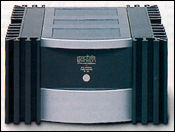| Columns Retired Columns & Blogs |
Mark Levinson No.334 power amplifier
My father could not resist buying electronic and photographic gear. As soon as he heard about a new Polaroid camera, or a new weather radio, tape recorder, or color television, he'd go shopping. He'd be even more eager to buy an updated version of what he already had, particularly if this meant there was a story to tell. He'd buy one for himself, and sometimes he'd give me and my three brothers one of our own for a birthday or Christmas gift. (I often thought he took more pleasure from giving to us than he did from getting his own.)
Footnote 1: Because the No.331 was designed for the widest open-loop bandwidth, its designers selected an underdamped system. Stereophile's bench tests confirmed this by identifying a rise in ultrasonic response, with a 1.5dB peak at 100kHz. There was some mild overshoot and a single cycle of ringing visible on the 10kHz squarewave response. Madrigal's engineers did not feel this test-bench result had any relation to the amplifier's sonic performance. Nevertheless, in the redesign of the No.334's output stage, they applied compensation to critically damp the amplifier's ultrasonic response.
 Dad would have loved the new Mark Levinson No.334 amplifier.
Dad would have loved the new Mark Levinson No.334 amplifier.
The 125Wpc No.334 is the second generation—introduced four years after its predecessor, the 100Wpc No.331—of the company's smallest 300-series dual-monaural amplifier. Even if he had been a No.331 owner, my father would have wasted no time in purchasing the 25% more expensive No.334. He'd have pointed to the No.331's and No.333's positive reviews in this magazine (Vol.19 Nos.1 and 12, respectively) and their Class A standings in "Recommended Components." He'd mention that the No.334 uses components and technologies derived from the $19,950/pair Mark Levinson No.33H monoblock (reviewed in Vol.21 No.1), which won Stereophile's 1998 Joint Amplification Component of the Year award. And he'd itemize the Madrigal accessories: the rugged white handling gloves, the optional Madrigal Balanced Bridging Adapter Kit ($375), and the No.331.5 cyanate-ester voltage-board update ($1950) for No.331 owners.
Opening the Carton
Even at 112 lbs shipping weight, the hefty Mark Levinson No.334 power amplifier is the baby in Levinson's 33-series dual-mono solid-state amplifier family. Its bigger brothers are the 250Wpc No.335 (155 lbs, $7900) and the 350Wpc No.336 (165 lbs, $9500).
Stacking the No.334 atop the No.331 was the only way I could tell them apart. The newer amplifier's subtle external cosmetic changes include rounded edges on the heatsink fins and curved silver faceplate, and a perforated grille in the top cover plate. All units certified for sale in Europe, and therefore come with an AC mains switch, which can be used to disconnect the control circuit power supply from the AC mains without having to unplug the amp itself. My father would have delighted in the three control ports set just below this switch: the remote turn-on trigger jacks; the Mark Levinson Communication Link Ports, which allow the amplifier to be controlled by a 30/300-series Levinson preamplifier; and two PHAST-compatible ports for two-way communication with a home automation controller.
Inputs to the amplifier can be managed via single-ended RCA or balanced XLR connectors—U-shaped shorting plugs connect pin 1 (signal ground) to pin 3 (signal, inverting) in each rear-panel XLR input to reduce noise pickup during single-ended operation. (These must be removed for balanced operation.) The Madrigal bridging input adapter uses the XLR inputs and short lengths of CZ-Gel cable to reconfigure the two channels of the 334 into a single, more powerful amplifier rated at 500W RMS into 8 ohms.
The No.334's output stage carries a 25% greater continuous power output rating per channel than the 331's. Its bipolar output power transistors are packaged in small plastic cases instead of the No.331's more microphonic metal TO3 cans, and are clamped to the heatsinks with an aluminum bar. The result is an output stage with lower noise, lower THD and IMD, and better squarewave performance (footnote 1). The protection circuit has been upgraded to prevent damage to the output stage if the amplifier is switched from standby to full operation when there is a short circuit at the speaker terminals.
Footnote 1: Because the No.331 was designed for the widest open-loop bandwidth, its designers selected an underdamped system. Stereophile's bench tests confirmed this by identifying a rise in ultrasonic response, with a 1.5dB peak at 100kHz. There was some mild overshoot and a single cycle of ringing visible on the 10kHz squarewave response. Madrigal's engineers did not feel this test-bench result had any relation to the amplifier's sonic performance. Nevertheless, in the redesign of the No.334's output stage, they applied compensation to critically damp the amplifier's ultrasonic response.
- Log in or register to post comments




































